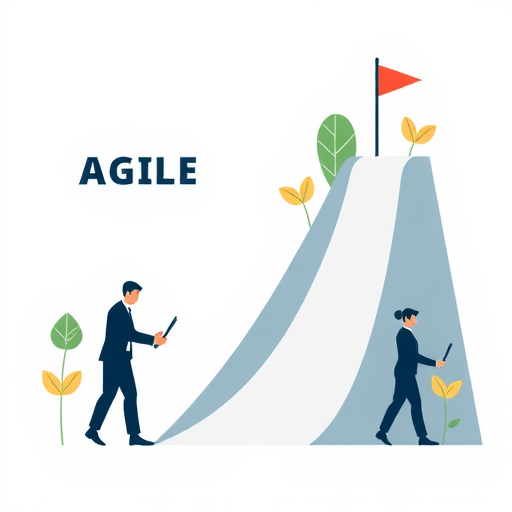In this article, we’ll discuss waterfall vs agile project management, the advantages and disadvantages of agile and waterfall project management methodologies, waterfall release, and agile roadmap.
What is Agile Project Management
A method that delivers projects and focuses on releases incorporating feedback. The ability of agile to adjust in iterations promotes adaptability and velocity. This method differs from the waterfall approach which follows a fixed path with only a few deviations.

With today’s businesses and customers requiring changes, agile offers flexibility.
Waterfall Project Management
The waterfall approach includes a well-defined sequence for project that do not go forward until the previous phase gets final approval. After a phase is completed, it can be costly and difficult to revisit the predecessor phase.
Waterfall follows a linear formula. This approach works well for projects that have recurring and predictive processes but can leave the teams flat-footed.
A missed scope or deadline change during the waterfall approach can lead to negative impacts. The illustration below shows a standard project using a waterfall with segmented time. This creates a lose it or use it mindset that encourages developers to request maximum in each window of time since there might not be an opportunity for iteration in the future. Typically teams that use waterfall attempt scope control through a change control process where every stakeholder agrees the contract does not change.
Example of Waterfall Release
Dependency Management and Blockers
Traditional styles of project management create critical paths where the project is unable to make progress until an issue is resolved.
Difficulty Obtaining Product Validation and User Feedback
The end consumer is unable to interact with incomplete product. Thus, priority issues like code and design go unidentified.
Advantages of Waterfall
- Needs less coordination due to well-defined process of phases
- The clear phase of the project enables the defined work to clearly
- Focus on designs and requirements
- The design phase is more structured and methodical
Disadvantages of Waterfall
- Hard to decompose work due to the strict sequence of phases teams are specialized
- Time wastage risk due to setbacks and delays
- More communication overhead between the transition phases
- Weak product engagement and ownership
Waterfall vs Agile Methodologies
Agile was initially adopted for developers who transitioned from sequential approach to a methodology that generated feedback and changes.
Iterative releases lead to many opportunities to:
- Adapt to changing circumstances.
- Gather stakeholder feedback.
- Build connections and relationships across different roles.
- Agile enables teams to be responsive.
Agile Project Management Example
A software team with a shared skill set is a great benefit. The overlapping skills result in flexibility where time and work don’t go wasted.
Agile Principles
- Agile project is divided into many increments
- Project requirements are segmented according to the importance
- Adjusts regularly to ensure the needs of customers are met
- Integrates execution with planning
Advantages of Agile
- Faster feedback cycles
- Early identification of problems
- Dramatic improvement in time to market
- Better visibility
- Team dedication drives higher productivity
- Flexibility in prioritization leads to value in delivery
The Disadvantages of Agile
- Inter-project dependencies and critical paths may not be well-defined in a waterfall
- Curve cost for organizational learning
- True execution with deployment has engineering costs and technical dependencies
Agile Roadmap
Requirements
Every initiative in the roadmap decomposes into requirements. Agile requirements change over time and capitalize on team understanding about the customer. Every team member develops an understanding through collaboration and conversation.
Backlog
Backlog creates the agile program priorities. The team includes backlog work items including bugs, architectural tasks, and new features. The product owner prioritizes the backlog work for the team.
Agile Metrics
Agile teams use metrics to thrive. Work-in-progress limits keep the business and team focused on the delivery of high-priority work. Control charts and burndown charts enable the team to predict frequency and diagram enables the identification of bottlenecks. These artifacts and metrics keep every stakeholder focused.
Agile Depends on Trust
Agile can’t work without trust among team members. It needs honesty about the product and the program. Conversations occur regularly, concerns and ideas are expressed regularly. This means that the team members should be confident in the ability of each other to execute decisions.
Conclusion
Agile is innovative for all kinds of projects. By offering the flexibility to changes, agile enables teams to deliver quality products. Agile builds accountability and advocates continuous improvement. Agile enables you to respond to changes while staying on track. And that’s a great approach for any project.
Waterfall vs Agile Project Management- FAQs
Can one do Waterfall and still be Agile?
With a waterfall schedule, the project team can work in an agile way through iteration releases to an acceptance testing.
What is the advantage of a small team when working with Agile?
Agile is best when teams are cross-functional and small. Small teams can collaborate closely, making it easy to maintain communication and flexibility. Smaller teams are better able to manage frequent changes and collaborate.
Is Agile more expensive than Waterfall?
Agile is expensive initially due to feedback loops but the expenses are reduced over time by delivering incremental value and addressing issues early. Waterfall has upfront fixed costs, which can result in high expenses if changes are made later.
Do follow our Trending Topics Section for more relevant articles
Do watch the Waterfall vs Agile Article Video Here
Do subscribe Our YouTube Channel for more relevant videos


